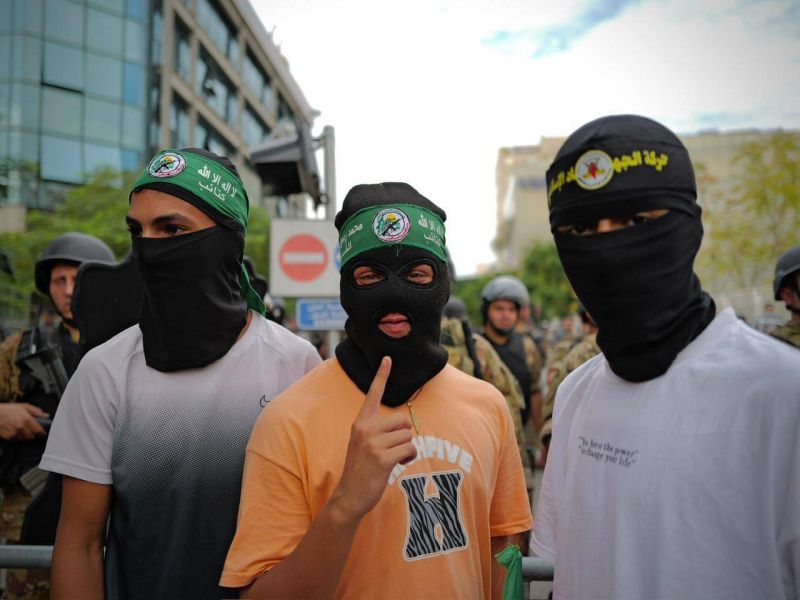
Protesters wear Hamas logos during a demonstration near the French embassy in Beirut, Oct. 31, 2023. (Credit: Matthieu Karam/L'Orient Today)
Follow our live coverage here.
When the Arab spring uprisings broke out in 2011 and the spark of revolution ignited Arab capitals, Syria was no exception.
A few months after people took to the streets in Damascus and in cities across Syria, Hamas, the Palestinian militant group which had been based in Damascus for almost 11 years at the time, had to make a decision: either to stand with the people or the regime. They chose the opposition, and they left Syria in 2012, to move to Qatar.
Meanwhile, Hezbollah decided to back Syrian President Bashar al-Assad’s regime, “given its stance [alongside] the ‘resistance,’” Mohanad Hage Ali, a researcher at Beirut’s Malcolm H. Kerr Carnegie Middle East Center, told L’Orient Today.
And so with the war in Syria quickly growing, the two groups found themselves on opposite sides of the fighting. “What later unfolded is that Hamas had a presence in Palestinian refugee camps in Syria,” which later became involved in the conflict while Hezbollah was fighting alongside Assad, Hage Ali said.
“That created a huge problem for Hezbollah and Iran and the relationship between them [Hamas and Hezbollah] strained. Iranian funding was also cut from the organization.”
A few months later after leaving Syria, the senior political leader of Hamas, Ismail Hanieh, seemed to cement that newfound tension. He told a crowd of thousands at Cairo’s al-Azhar Mosque: “I salute all the nations of the Arab Spring and I salute the heroic people of Syria who are striving for freedom, democracy and reform.”
Worshipers responded to Hanieh’s remarks by chanting, “No Hezbollah and no Iran. The Syrian revolution is an Arab revolution.”
Hamas’ support for the opposition was simultaneously announced at a rally in the Gaza Strip and further isolated Assad in the region, leaving Iran and Hezbollah as the Syrian leader’s only major Middle East allies.
‘The Arabs abandoned us’
As the years passed, however, it became evident that a regime change in Syria was not underway, Heiko Wimmen, Project Director of Iraq, Syria, Lebanon at the International Crisis Group, told L’Orient Today.
Hamas found itself isolated. Under the new leadership of Yahya Sinwar, who was elected in 2017, the group pushed a new agenda of reconciliation between Hezbollah, Iran and Hamas.
“All the Arabs abandoned us so what options do we have?” Wimmen recalled one senior Hamas member telling him. Though Hamas retained its main headquarters in Qatar, the main source of funding, training, equipment and salaries for the group’s members came from Iran, he added.
“Iran was always public about its support on various levels to Hamas, but its primary funds went to military training and equipment. In fact, Iran had taught Hamas members how to manufacture their own rockets within the Gaza strip,”Hage Ali said.
That reconciliation, it appears, included Gaza. “Whatever capacities Hamas has built up in Gaza it owes a lot to Iranian support, material logistics, and training support. Once it was clear that a regime change was not going to happen in Damascus, and they felt like the rest of the Arab world, except for Qatar, had abandoned them, they went back to Iran,” Wimmen explained.
“The Iranians were the only ones supporting [Hamas] in their struggle against Israel, in the end it is the choice they had to make, so they went and made up with the Syrians in 2019,” Wimmen said.
Still, according to Hage Ali, “there are different views within Hamas regarding the reconciliation within Iran, not all are on board with it.”
Hezbollah and Hamas' ‘shared operation room’
Signs of this closer relationship became all the more apparent in 2021, when Hezbollah coordinated with Hamas on the latter’s “Saif al-Quds” operation, “where Hamas drew a red line of Israeli violation of al-Aqsa and Sheikh Jarrah [in Jerusalem],” Wimmen said.
The so-called “Saif al-Quds” battle took place in May 2021, and was dubbed the “11-day war.” After several Israeli incursions into the al-Aqsa Mosque that Ramadan, the spokesperson for Hamas’ armed wing, the al-Qassam brigades, a mysterious figure known as Abu Ubaydah, gave Israeli occupation forces a 6 p.m. deadline to withdraw from Al-Aqsa Mosque and stop a far-right settler march. On the deadline, a barrage of rockets was fired from Gaza into Israeli settlements surrounding Jerusalem. It was then that Israel officially announced it was going to war with Gaza.
According to Wimmen, “Hamas had a shared operation room with Hezbollah during the Saif al-Quds battle and they made no secret of it.”
“In this year’s Al-Aqsa flood battle Hezbollah is coordinating its attacks on the border in solidarity with Gaza, and so this could show that they are still sharing an operation room, either physically or virtually,” Wimmen explained.
But why were Hezbollah and Iran eager to take Hamas back?
“Hamas is an obvious asset to Hezbollah. If your main enemy in the region is Israel and you are a champion of the Palestinian cause — no matter how sincere you are — you need a Palestinian actor to support you, a Palestinian ally, and what options does Hezbollah have other than Hamas?” Wimmen said.
The two groups both have strategic reasons to remain allies, Hage Ali added.
While the rival Fatah movement, part of the Palestine Liberation Organization (PLO), is quietly working and coordinating with the Israelis and Americans elsewhere in Palestine, “Hamas controls Gaza,” says Wimmen. “And since Hezbollah formed an alliance with an actor that controls Gaza,” both groups could coordinate to make attacks on Israel at the same time, from two separate fronts.
“Hamas showed it can also penetrate to the West Bank, like it did in the operation on Oct. 7,” he added.
Will they remain allies?
Wimmen explains that Hamas is mainly interested in strategic alliances and decisions and “at any point it can choose to make a different decision. But what are its other options?”

